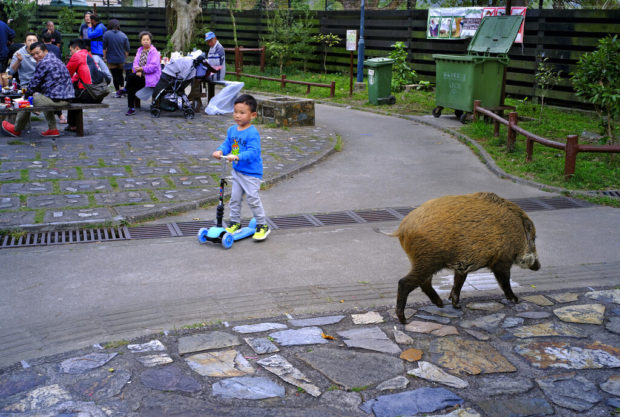In the year of the pig, Hong Kong debates its boar problem

In this Jan. 13, 2019, photo, a wild boar scavenges for food while local residents watch at a Country Park in Hong Kong. Like many Asian communities, Hong Kong ushers in the astrological year of the pig. That’s also good timing to discuss the financial center’s contested relationship with its wild boar population. A growing population and encroaching urbanization have brought humans and wild pigs into increasing proximity, with the boars making frequent appearances on roadways, housing developments and even shopping centers. (AP Photo/Vincent Yu)
HONG KONG – Like many Asian communities, Hong Kong ushers in the astrological year of the pig. That’s also good timing to discuss the financial center’s contested relationship with its wild boar population.
While some argue for an ongoing cull to keep the boar numbers down, others urge preservation, a position the government has lately embraced.
A growing human population and encroaching urbanization have brought humans and wild pigs into increasing proximity, with the boars making frequent appearances on roadways, in housing developments and even in shopping centers.
The debate about how to handle them comes as the densely populated city of more than 7 million people is being festooned with pig-themed decorations in preparation for the holiday that officially begins on Feb. 5.
Not far from its cramped apartment blocks and neon lights, Hong Kong has plenty of green land, traditionally home to a variety of animals, including wild boars. Some areas where homes are close to parks or forests, such as Aberdeen in Hong Kong Island’s south, have become popular spots for growing numbers of boars to forage for food amid the garbage cans.
The boars often don’t hesitate to get close to people and traffic.
The government’s Agriculture, Fisheries and Conservation Department says it doesn’t know how many wild boars there are in Hong Kong. But it has acknowledged a big increase in public complaints about the animals over the past five years — from 294 in 2013, to 738 in 2017.
That prompted a review of policy starting last year, which included a halt to hunts by volunteer teams for boars deemed to be threats to property or public safety. Instead, the government is extending a policy of sterilizing the animals and feeding them contraceptives, as well as discouraging the public from providing them food. It also captures and tries to relocate wild boars away from residential areas as an alternative to killing them.
However, one local organization, “Wild Boar 70,” is lobbying for the renewed culling of the wild boar population.
Other countries with large populations of wild pigs have a policy of controlling them by killing 70 percent of their numbers every year, according to spokesman Wesley Ho.
“Our goal is hopefully to raise public concern about Hong Kong’s current problem of wild boar overpopulation, and about exactly what kind of animal these wild boars are,” Ho said.
Nations such as France and the U.S. have to deal with large-scale damage to agriculture wrought by feral pigs, largely appealing to hunters as a solution.
Denmark this month began erecting a 70-kilometer (43.4-mile) fence along the German border to keep out wild boars in an attempt to prevent the spread of African swine fever, which could jeopardize the country’s valuable pork industry.
With agriculture a minor player in the local economy, such concerns aren’t much of an issue in Hong Kong’s current debate.
However, Roni Wong, of the Hong Kong Wild Boar Concern Group, says that development expanding into Hong Kong’s green areas is causing the increasing confrontation between humans and animals.
“The situation that we are seeing is that their habitats are slowly being urbanized,” Wong said. “So their chances of feeding, and their habitat, are being destroyed and affected.”
By now, Hong Kong social media users are highly familiar with videos of wild boars taken by drivers and pedestrians. Sometimes they show a herd rushing across a road in front of cars in a manner that looks dangerous to both themselves and drivers.
Other times, they come across as cute, cuddly and unthreatening, often raising a snout to the camera as if in greeting.
Hong Kong’s government says it hopes to complete its policy review of wild boar management within the year. Until then, the year of the pig seems primed for many more encounters between boar and man in Hong Kong’s mix of hilly forest and urban sprawl. /gsg